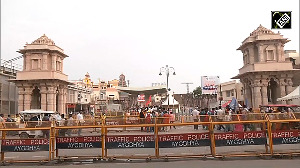With allegations of corruption echoing in the higher echelons of the judiciary, the government for the first time this year sought to draw a legislative line bringing judges within the purview of legal scrutiny.
The Judges Inquiry Bill is still being vetted as the Law Ministry and the Parliamentary Standing Committee on Law and Justice disagreed whether the top judicial office of Chief Justice of India should be kept out of it.
The debate over how far the judges can be kept immune from public inquiry was triggered by Justice Jagdish Bhalla's elevation as Chief Justice of the Chhattisgarh High Court.
Charges of corruption flew thick and fast as former President A P J Kalam returned his file asking for a review of Justice Bhalla's promotion.
The disagreement over the top judicial office accountability was further aggravated as another controversy surfaced later in the year -- former Chief Justice of India Y K Sabharwal was caught in allegations of nepotism in allotment of plots in Noida.
The proposed law provides for setting up a National Judicial Council to probe any misconduct by a judge of the Supreme Court or high courts. It also seeks to spell out a procedure through which one can make a complaint to the NJC.
Hardly had the opposition protests against the 'interference' of the Law Ministry in Bofors case subsided, another controversy erupted -- the ministry had allegedly advised the External Affairs Ministry on the futility of chasing the accused Italian businessman Ottavio Quattrocchi, who had escaped to Argentina for good.
On the upside, several reforms in the functioning of judicial system were initiated under the supervision of the Law Ministry.
Top among these is the setting up of e-courts, where a petitioner can file a complaint or affidavit from any corner of the country, without having to physically travel all the way to the court.
With a view to making quick and less expensive justice accessible to the common man at the grassroots level, the ministry also introduced Gram Nyayalalyas Bill, which seeks to set up courts in rural areas.
Judges and court staff were exposed to the advantages of information technology. So far 8,700 judicial officers and around 32,000 court staff have been given a three-month computer training.
Though speculation about outsourcing has been doing the rounds, the Law Ministry maintained it had no proposal to allow foreign solicitors to participate in the judicial process.
However, the issue of allowing foreign law firms to set up their offices to give legal advice and assistance on foreign law remains under discussion with the stakeholders, including the Bar Council of India.
The Law Commission brought out certain reports of public interest on issues such as withdrawal of life support from terminally-ill patients, and enhancing punishment in case of dowry death.
The commission recommended setting up of a three-member panel of reputed medical persons to clear the decision on withdrawing life support system from the terminally ill. It also said the patients and their relatives should notify a high court about such a decision, so that the doctor is immune from legal action.
But the ministry set aside the recommendation.
However, the commission received a pat on the back as the Chief Justice of India K G Balakrishnan called for implementing its serious recommendations.
In another report, the Commission recommended the enhancement of sentence in a dowry death case from seven years to ten years, but it said the crime does not warrant a death sentence. However, if it is a murder, then an accused can be tried under an additional Section 302 of the IPC, in which punishment can go up to death.
Despite hectic efforts to fill vacancies in the Supreme Court and High Courts, the shortfall remains. The apex court has a strength of 22 judges against the sanctioned 26. In various High Courts the working strength remained at 589 judges against the sanctioned 689.
In an image makeover exercise, the ministry also rejected the Transparency Internationals Global Corruption Report, 2007 which cited 77 per cent of the general public as saying the Indian judicial system was corrupt.
Keeping in view the ever-growing pendency of cases in courts across the country, the Law Ministry asked various state governments to start evening courts, but only Gujarat volunteered by starting double-shift facility in the state courts.
The running battle for authority between the Supreme Court, executive and the legislature found expression in Prime Minister Manmohan Singh's address to chief ministers and Chief Justices of various High Courts when he cautioned courts against 'the judicial over-reach.'
However, Law Minister Bhardwaj threw his weight behind the judiciary, saying courts remained supreme and power for judicial reviews flows from the Constitution and cannot be taken away.






 © 2025
© 2025